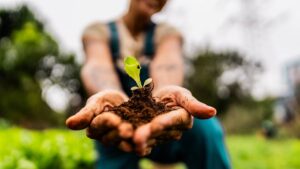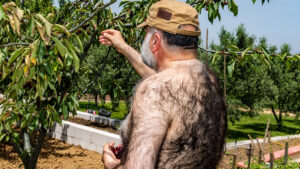RLF AgTech sprouts sustainable future after nurturing key business units

RLF AgTech is supporting farmers to grow crops more efficiently and sustainably. Pic: Getty Images
- RLF AgTech has undertaken a restructure to build long-term sustainable growth
- Company is at forefront of precision agriculture to improve crop yields and quality
- RLF has set up around 500 Australian distributors in past 12 months, with focus on local operations
Commercial nutrition solutions provider for the agriculture industry, RLF AgTech is shaping up for strong growth, as precision agriculture continues to gain global relevance.
Focusing on precision agriculture, RLF AgTech (ASX:RLF) is up ~37% YTD and has positioned itself at the forefront of a critical and rapidly evolving global challenge – producing more quality food – efficiently and sustainably – to meet demands of a growing population.
With a history spanning around 30 years, RLF listed on the ASX in 2022 and is now poised for growth following a period of transition.
Acting managing director Gavin Ball first invested in RLF around 14 years ago, realising the company’s potential.
Following a restructure around 12 months ago, Ball stepped into the top role. He credited the tireless efforts of the entire RLF team in pushing the company in the right direction, laying the foundation for future growth and profitability.
“We’ve managed to get to a stable footing now, where we can demonstrate growth and viability of the business,” Ball said.
“Our strategy for the past 12 months has been plain vanilla management 101 with a focus on revenue and commercial opportunities.
Four revenue businesses make up RLF AgTech
RLF’s flagship Plant Proton Delivery Technology (PPDT) allows farmers to cultivate crops with enhanced yields, improved quality and increased nutritional value, while bolstering the plants’ capacity to store and reduce atmospheric carbon.
The company operates four revenue-generating divisions including:
- RLF China
- RLF Asia
- RLF Australia; and
- RLF LiquaForce.
In May 2024, RLF acquired fertiliser company LiquaForce’s core business and assets for $4.5 million in cash and shares to help drive expansion into sugarcane, broadacre and horticulture farming.
LiquaForce has two manufacturing sites in Queensland, allowing for expansion to support increased sales and RLF manufacturing.
Ball emphasised that while stabilising all its business units has been the company’s simple, overarching strategy, predominant focus has been placed on RLF LiquaForce, which has provided a strong foundation in Australia with infrastructure and revenues.
RLF Australia meanwhile, is also a crucial component with the company’s technical business offering a range of micro-nutritional products, built throughout its history, and based on grower needs and demands.
“We have a lot of products but focus on 16 key ones in Australia and about 30 in China,” Ball said.
“They range from more advanced broad-spectrum products to specific products focused on the different stages of crop growth or particular crops.”
Recently, RLF added a biological range of products for broadacre farming to complement its existing plant nutrition range, an area Ball said he is interested in expanding over the short term.
Establishing a strong distributor model for growth
Ball noted that within Australia the landscape for selling agricultural products is through distribution networks such as Delta Agribusiness and NRI Australia.
“Our first strategy for our Australian business was to set up manufacturing and then to set up distribution,” he explained.
The company’s plan for 2025 was to establish 100 distributors with 400 by 2028, a goal it has already reached.
“Our growing distribution reflects our years of trial data and substantiation, so we’re not bringing in new products but trusted products which have validation,” Ball said.
Continuing the growth of its Australian business will be RLF’s primary focus for 2026.
Right time for growth with precision agriculture in focus
With growers globally increasingly embracing science-driven precision agriculture, RLF is well-positioned to capitalise on the trend through its advanced plant nutrition solutions.
“Growers are looking at the science behind crop growth to get better yields and better-quality produce,” Ball said.
“A lot of our trials now are around quality, which for the grower determines how much they get paid for their produce.
“If you have a higher sugar content in sugar cane, more protein in grain for wheat, or better-quality fruit and vegetables, growers get more money.”
Ball said adapting crops for climate change, and a growing global population had also become important in the agricultural industry.
In RLF’s Asia-Pacific business, a major challenge for crop yield is storm and rain damage. For example, mangoes can fall and rot when the stalks holding the fruit to the tree aren’t strong enough to withstand the weather.
“Having products that can grow stronger stalks to hold the fruit becomes important,” he explained.
“Rice gets dislodged with a heavy wind and rain, so we’ve developed products which grow thicker stalks and stronger root systems to help withstand climate effects, which have both an agronomic and yield benefit.”
Hillston project validates RLF’s carbon-farming potential
In March RLF reported positive early results from its Hillston Soil Carbon Project, designed to verify the effectiveness of its fertiliser technology to increase soil carbon levels, reducing agricultural emissions, and cutting reliance on synthetic fertilisers.
Following application of RLF’s Accumulating Carbon in Soil System (ACSS) products to a single crop, Hillston has delivered measurable improvements in soil organic carbon, a reduction in greenhouse gas emissions, and improvements in fertiliser efficiency.
The Hillston project is part of RLF’s broader strategy to position itself as a leader in carbon-smart farming solutions, aligning with increasing ESG and sustainability disclosure requirements and global demand for verified carbon reduction initiatives.
“Sustainable, high-quality food production is essential globally, and represents a significant market opportunity for RLF,” Ball said.
With a solid operational base, an expanding range of proven products, and growing presence across key markets, Ball said RLF demonstrated the practical impact of its approach to agricultural technology.
“We’re increasingly a story of delivery of products in use, results on the ground and revenue coming through,” he said.
“With positive momentum in the Australian market and early signs of scalable growth, we’re well placed to benefit from rising interest in smarter, more sustainable farming solutions.”
At Stockhead, we tell it like it is. While RLF AgTech is a Stockhead advertiser, the company did not sponsor this article.
Related Topics
UNLOCK INSIGHTS
Discover the untold stories of emerging ASX stocks.
Daily news and expert analysis, it's free to subscribe.
By proceeding, you confirm you understand that we handle personal information in accordance with our Privacy Policy.








